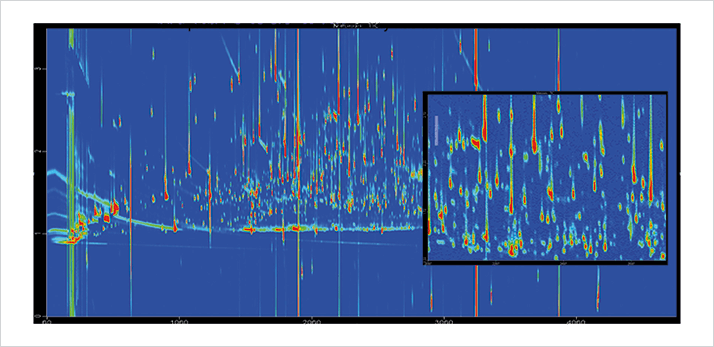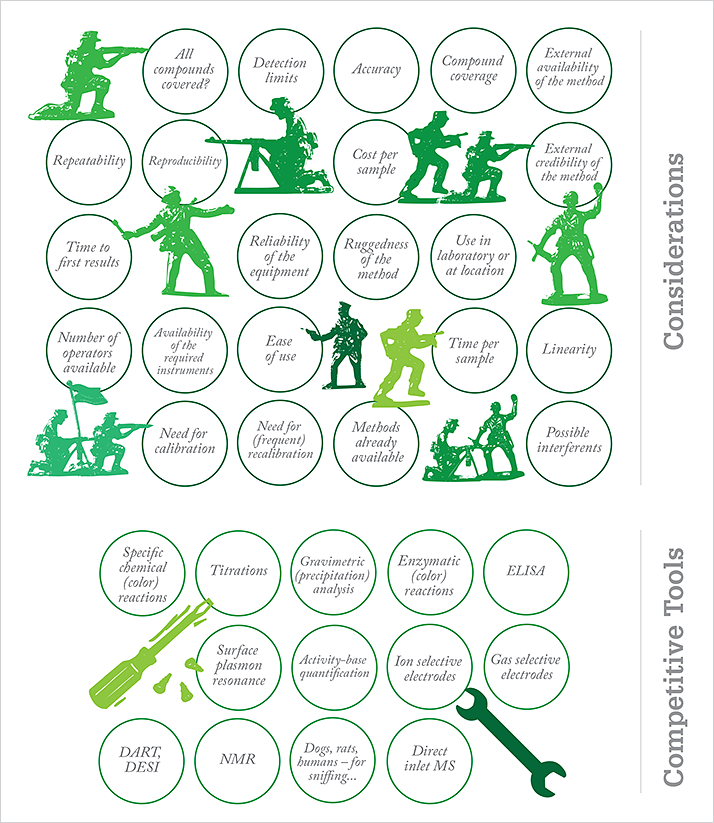
I recently gave a presentation to a group of separation scientists from the Royal Dutch Chemical Society about my chromatography concerns. Many people found the lecture amusing, which was my intention. After all, I used irony and humor to hammer home the message. Irony is useful in approaching our problems, failures and shortcomings, and original humor is about creativity. Creativity, of course, leads to new ideas and combinations. So, while the delivery was amusing, my real intention was to provoke and inspire people about a topic I am passionately serious about. Here, I share the same message with you.
Chromatography all around us Chromatographers are everywhere. We are at the core of every scientific discipline; we work with people in the environmental field, in the food field, in the medical field… There is hardly any science that does not need us and that is our main strength. Science is about building hypotheses; people use analytical chemistry – and chromatography – to gather information for hypothesis generation. Later, they use analytical chemistry for hypothesis testing. As a consequence, we are continuously faced with great challenges that should allow us to grow.
But... We don’t really get any recognition even though we typically do a great job. If you consider chromatography and mass spectrometry (chrom-MS), we are always faster and always more sensitive than other techniques. And yet, even though we solve every problem on “the analytical battlefield”, we rarely get any of the credit. The danger? Well, we’re on a sinking battleship – one that’s being eaten by sharks. Certain elements of chromatography have been completely transferred to the users – who can do a lot of their chromatography themselves and don’t need us anymore. In principle, we should have more free time to work on high-end techniques that will be essential in solving the problems of tomorrow. But because we typically don’t get enough credit or attention, we don’t get the funding we need either. The sharks are very effective – in other words, we have become very efficient at transferring simpler methods and tools to users – and that’s a good thing, isn’t it? They are eager to use our techniques because they work and are very useful – it’s chromatography’s success story. I’m not here to challenge that. The problem is that we are not building the front end of the ship fast enough to stay afloat. Let’s not follow in a long line of disciplines that have sunk and disappeared: the typing department, the calculation department, the organic chemistry department... In all cases, standard work was passed to the requesters themselves, without any thought on developing new, high-end tasks. The problem is the same for all chemical analysis methods, but to a different extent (less so if your method is considered more difficult – spectroscopy, for example).

Competition in the toolbox The toolbox is a problem for the industrial analytical scientist. A question comes in that needs to be answered. Most of us have a very heavy toolbox with (too) many techniques – chromatography is just one of them. A good analytical scientist needs to know what every single technique can do and needs to be able to select the best method. And we must be able to use the chosen technique. It’s about knowing many methods and being able to get the maximum out of every single one of them. That is difficult. I use the toolbox analogy because it also implies a potential hazard. If you only have a hammer, you cannot solve all problems. And, if you only have experience of working with hammers, you will approach every problem as if it were a nail. We could consider developments in chromatography as increasingly big hammers. Think about GC where we can now inject 100 µl instead of 1 ml, or UPLC where we are now faster, or comprehensive chromatography that offers us multiple advantages. Handling a bigger or heavier hammer requires more from the analyst. And yet it remains a hammer, and it will never be suited for precision screw driving. Many analytical challenges exist, and some of them could absolutely benefit from state-of-the-art chromatography. Others will never benefit from chromatography – and a few might inspire new research in chromatography, if we are listening.
What is the chromatography hammer used for? It’s largely used to find out what is present in a sample and how much there is. To a lesser extent, chromatography is also about finding composition – property relationships. There are numerous other techniques that can do the same, but chromatography is unsurpassed in terms of sensitivity, reliability, availability, cost and speed. So yes, chromatography is a very important technique in the toolbox, but it is not the only tool. There are numerous other techniques available for quantitative analysis. Most of them overpromise and under deliver, or are of limited general relevance and applicability. Capillary electrophoresis is not reliable enough, surface plasmon resonance not selective enough. ELISA does not work for small molecules, near-infrared spectroscopy is too matrix dependent, should I go on? Several other methods allow very rapid analyses of a reasonable quality, but require many extras and add-ons when more accuracy is demanded - much like buying a cheap computer and realizing that several upgrades are needed before it is up to the task. For me, NMR is an example.
Quantitative NMR is very fast in generating a reasonable number, offering very fast initial ‘quick and dirty’ answers. But getting the analysis to the same quality as chromatography requires at least the same time for method development and time per sample as chromatography, if not more – and with no guarantee you will ever get there. Here’s a sentence from an abstract from Yulia Monakhova’s upcoming keynote lecture at 2015’s PANIC (Practical Applications of NMR in Industry Conference): “Nuclear magnetic resonance (NMR) spectroscopy is now of growing importance in the field of qualitative and quantitative food analysis. In this regard, NMR allows analysis in two ways within one experiment: namely, using targeted and non-targeted approaches. NMR provides qualitative and at least semi-quantitative information even without pure compound standards more rapidly than with any other currently available spectroscopic or chromatographic method.”
Is NMR really that fast? Remember, the world record in GC is nine compounds in 0.6 seconds. Now that’s fast. Calibration is certainly a very strong point for NMR – you do not need standards. And in chromatography, response factors between different compounds can differ up to, well, about infinity... But what annoys me is that NMR is often presented as an alternative for chromatography in scientific literature. Apart from a few niche applications, it is not; the technique is complementary to chromatography. If the quick and dirty answer suffices then that’s great. If not, chromatography can raise the level of analysis.
- Universal extraction sample prep methods (QuECheRS…)
- Universal derivatization methods (oximation-silylation).
- Higher resolution mass spectrometry.
- Universal gradients (GC: on-column injection, non-polar thin film, to very high temperature; LC: C18, Acetonitrile/water (acidified), wide range with DAD and ESI+).
- Use Comprehensive LC×LC and GC×GC (or even LC×GC). Why? i) two phases are better than one, ii) gain peak capacity, and iii) able to see groups and trends.
- Develop a flow chart (to avoid having to think hard every time a new sample arrives).
- Improve library-searching skills.
- Start a database of questions.
- Create your own spectral databases.
- Stop at ‘fit-for-purpose’, even if you can easily do much better...

Staying relevant I am absolutely aware that chromatography and mass spectrometry are enabling techniques. We need to work with those scientists who have the real challenges to develop our field, but in practice many people do not choose to work with chrom-MS initially because it takes us too long to get a first result. Instead, they choose other enabling techniques, like NMR, where the route to a first result is faster. Typically, those initial techniques are not good enough in the long term and chrom-MS is drafted in again (when the initial credit has already been taken). Users want their ideas confirmed quickly. With chrom-MS, you first have to develop a method and then it takes weeks to get it running and validated before producing good (or the best) results. Because of our slow response, we are not part of the mission to explore new fields. For example, NMR has been widely used in initial metabolomics studies and is still presented as the key technique in this area. In reality, more or less all metabolomics platforms nowadays are based on LC-MS and GC-MS. The same happened in food safety and the detection of pesticides. There was a lot of work done on sensors to detect pesticides, PCBs and dioxins - certainly sensors work – but if you really want the best results, it’s back to chrom-MS. We need to be on the frontlines of the battlefield, not mopping up and minesweeping. In other words, we are not part of the discovery, but a service hired in afterwards. If we could have delivered results quicker we would have been part of the reconnaissance mission and included in the victory celebration.
Battling history We have another problem: the hangover of previous experience. Every chemistry student – and some in other scientific disciplines – have used chromatography at some point in their education. They worked on a lousy instrument somewhere as a graduate student and did some experiments. They think: “I can do chromatography. Chromatography is simple. Chromatography is slow.” I have a brush, so I can paint. But they are not aware of the vast improvements we have seen. When people say the technique is fully developed, they often mean: “I cannot develop it any further.” But an expert can! I’ve heard statements about our technique being mature for at least a decade or so, but look at what we’ve seen since then: large volume injection, MS connected to every LC or GC, comprehensive chromatography, UPLC – so 10 times faster, 100 times more sensitive and 1000 times more certain. Such growth rates are seen in infants, not mature adults. Catalysis is mature, engine development is mature, organic chemistry is mature. My car still uses 6.5 liters of gasoline per 100 km – like my previous car, and the one before. Where is the progress?
I remember my first chromatography experiments over 30 years ago – yes, the instrument looked somewhat similar, but the accuracy, selectivity, sensitivity, and reliability today is far, far superior. Unfortunately, we fail to tell people that we have much more to offer. In fact, because we have to fight against a misunderstanding of what analytical chemistry – and in particular chromatography – can offer, telling is not enough. When someone comes to you with a sample and you tell them that you are 10 times more sensitive and 100 times faster than in the past, they may not care or even believe you. We need to show what we can do. We must convince others of our ideas and abilities, and then give them some form of preliminary results very soon afterwards. Clearly, we are not adept at this last aspect. Preparing our first result takes us far too long. The analysis of the second sample hardly ever takes over an hour, but that first sample? It can take us weeks, if not months.
Faster first results I’ve done a lot of thinking about why chromatography is so slow. There are a number of reasons, but I think the biggest problem is that we simply have too few universal methods. Why? Because we have developed ‘the best method’ for specific applications. Unfortunately, such top-class methods don’t help when proving our initial capability in a new project or application. If we want chromatography to be taken seriously in the early stages, we don’t need a perfectly validated method with the best in selectivity, sensitivity and so on. We need to show that we can do ‘quick and dirty’ too – and that we can do quick and dirty better than the rest. We desperately need more universal methods for sample preparation, more universal methods for chromatographic separation, and broader compound coverage. In many ways, it’s about accepting imperfect results, which is a psychological barrier for us. We chromatographers always strive to get the best accuracy, reliability and sensitivity achievable. But while we’re busy working on that – the competition has swept across the battlefield and stolen victory. In the initial ‘show and tell’ phase we need to move towards a fit-for-purpose mentality rather than a world-record beating mentality.
- Shorter time to first results
- Localized compositional analysis
- Molecules in context (neighbours and interactions)
- Time-resolved analysis
- Taking the instrument to the sample
- Fewer methods and instruments
- Easier calibration
- More ‘dirt-resistant’ systems
- Reduced environmental impact (chemicals and power)
- Reliable black-box operation

A call to arms! As chromatographers, we are too critical and too shy about our own work. We fight against each other instead of joining forces and comparing our technique with other methods. We have a lot to be proud of so we should raise the banner for our achievements. We have instruments in space, in submarines and everywhere in between. But our success in making our techniques available for anyone who needs them is now working against us. Chromatography is no longer ‘sexy’. Sexiness is related to how many instruments are around (preferably as few as possible), how big they are, how expensive are they, how shiny, how difficult to operate... In chromatography, the difficult step is wet chemistry, which is seen as low-level work. And yet, once you have a good chromatogram, getting information out of it (the high level desk work) is simple and short. In spectroscopy, it is the other way around. The lab work (the wet chemistry) is short, but getting any information out (the intelligent desk work) takes time.
In some ways it’s also about PR and marketing. In society, there are numerous examples of failed sophisticated tools and techniques, but also examples of mediocre technologies that shot to fame. We cannot rely on fellow chemistry academics from other disciplines to give us a better name. We should work with experts from other fields, such as physics and big-data sciences, to deliver new concepts and insights. That said, we must always keep benefit to society at the forefront. We must find answers to challenges, eliminate hurdles by generating solutions, cash and intellectual property. We must cooperate with those who have challenging problems and work with instrument manufactures to generate equipment to solve current problems for users. We must make the effort to join in on new discoveries. Let me be perfectly clear: the experienced chromatographer is not under threat. If you have good chromatography and MS skills and high competency, you will be of great value to industry. Just don’t forget that we are on a battleship that is being eaten by sharks – fortunately, we have plenty of room for improvement (see Ten Targets for Change).
As an industrial scientist, I am realistic; analytical chemistry is an enabling science and, for me, there is no discussion about that. But enabling has nothing to do with being irrelevant. We are not getting the credit for what we do. We are everywhere in science and society, but we lack recognition and, as a result of that, don’t have sufficient funding support. In summary, we need to provide first results quicker or we will always be last onto the battlefield. We need to improve our PR and marketing. And finally, perhaps we should not give credit away so easily when we had a crucial part to play in the victory. It’s time to turn the tide of war and get recognized.

Hans-Gerd Janssen is Science Leader Analytical Chemistry, Unilever Research Vlaardingen, and Professor of Biomacromolecular Separations, van ’t Hoff Institute for Molecular Sciences, University of Amsterdam, The Netherlands.




